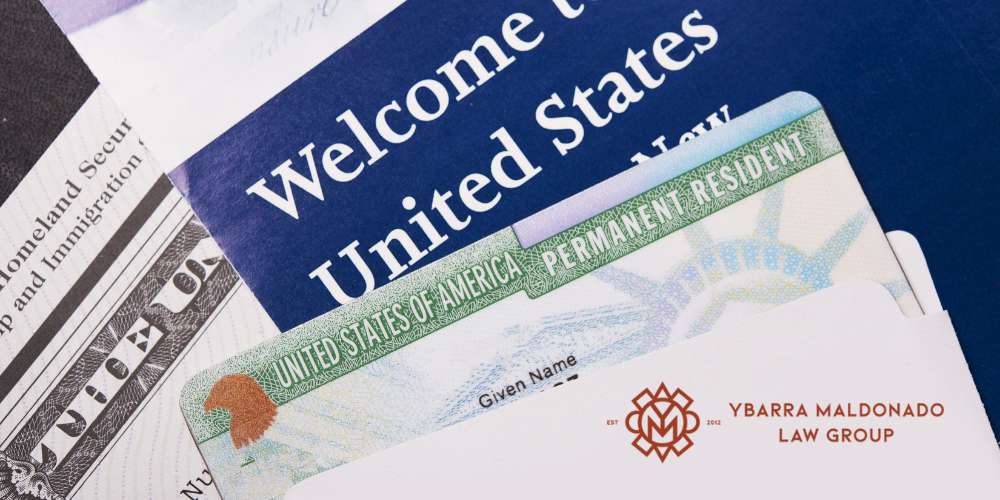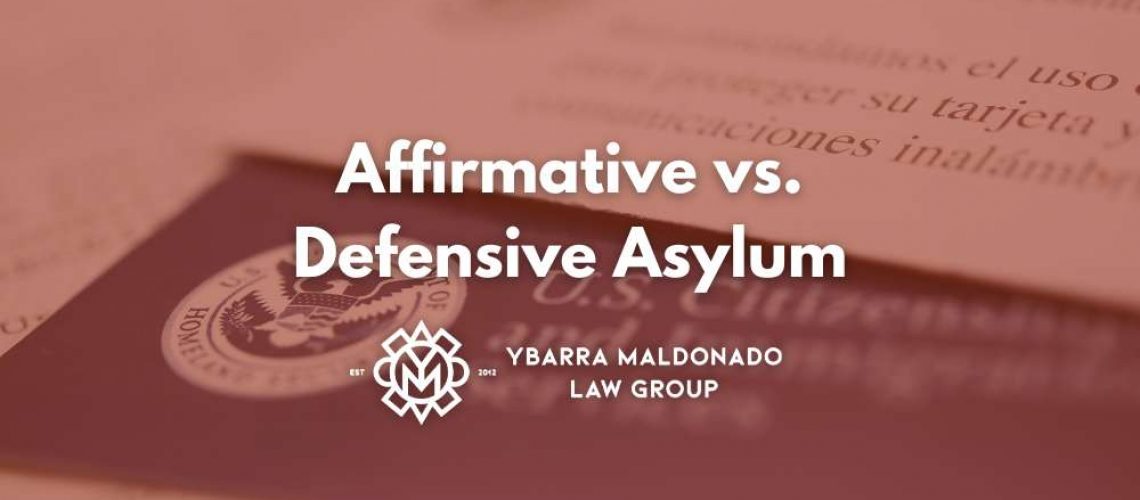Understanding the difference between affirmative vs. defensive asylum is important when applying for protection in the United States. Both processes are designed to assist individuals fleeing persecution in their home country. However, they each follow different steps depending on your specific situation. Knowing which process applies to you is key to giving you the best chance at a stable future.
At Ybarra Maldonado Law Group, we help families in Phoenix, AZ, and Miami, FL, understand their rights and apply for asylum in the U.S. To schedule a consultation with an experienced immigration attorney, call (602) 910-4040 or contact us online today.
What is the Difference Between Affirmative and Defensive Asylum?
Affirmative and defensive asylum are two different ways a person can apply for protection in the United States, depending on when and how they make their request.
In the affirmative asylum process, you make the first move by filing an asylum application with the United States Citizenship and Immigration Services (USCIS) before you are in removal proceedings. This means you are not yet facing deportation, but are physically present in the United States and wish to request asylum based on a credible fear of persecution in your home country.
In the defensive asylum process, you ask for asylum as a defense after being placed in removal proceedings. You present your asylum claim in immigration court, and an immigration judge decides your case.
Both affirmative and defensive asylum are options for asylum seekers, but the steps are different depending on your situation.

What is Affirmative Asylum?
Affirmative asylum is for people who are physically present in the United States and are not yet in removal proceedings. You may apply for asylum regardless of your current immigration status, as long as you apply within one year of arriving in the U.S. Many people enter the country on a visa for work, school, or travel and later file an affirmative asylum application with the USCIS.
How to File Affirmative Asylum Application
To initiate the affirmative asylum process, you need to complete and submit Form I-589 to the USCIS. You must apply within one year of entering the U.S. unless there are extraordinary circumstances that explain the delay.
After applying, you will be required to submit to fingerprinting and background/security checks. The USCIS will also schedule an affirmative asylum interview to learn more about your case. During the interview, a USCIS asylum officer will ask about your past, your home country, and why you are seeking asylum.
Please note that you have the right to bring an asylum and refugee attorney with you to your asylum interview. Your asylum attorney can help you understand the questions that may be asked, prepare your documents, and speak on your behalf if needed.
Where to File Affirmative Asylum Application
Affirmative asylum applications must be sent to the correct USCIS service center based on where you live. It’s important to follow the filing instructions listed on the USCIS website; otherwise, your application may be delayed or rejected.
A Phoenix or Miami immigration lawyer from our law firm can help ensure that your affirmative asylum application is prepared correctly and sent to the right place.
How Long Does Affirmative Asylum Take?
After your affirmative asylum interview, a decision is usually made within a few weeks. The USCIS aims to issue a decision within 180 days from the date you filed your asylum application. Unfortunately, delays can happen. If there are extraordinary circumstances, such as the need for more evidence or background checks, the process may take longer. Some affirmative asylum applicants receive a decision shortly after their interview, while others may have to wait several months.
An immigration attorney at Ybarra Maldonado Law Group can keep you updated on your case and prepared for what’s next.

What is Defensive Asylum?
Defensive asylum is when a person requests asylum while they are facing removal proceedings in immigration court. This means the person is at risk of deportation and is using asylum as a defense to stay in the United States.
Individuals are usually placed into the defensive asylum process in one of two ways. The first is when USCIS denies an affirmative asylum application. In this case, the individual is sent to immigration court to continue their case in front of an immigration judge.
The second way is when a person is placed directly into removal proceedings. This can happen if they are caught in the United States or at a port of entry without valid legal documents or are in violation of their immigration status. It can also occur if someone is stopped by U.S. Customs and Border Protection while attempting to enter the country, is placed in expedited removal proceedings, and, after a credible fear screening, an asylum officer determines that they have a reasonable fear of persecution or torture in their home country.
If you are a defensive asylum applicant, a Miami or Phoenix immigration lawyer from our team can fight for your right to stay in the U.S.
What are the 3 Parts Included in the Defensive Asylum Process?
The defensive asylum process includes three main parts. These are the Master Calendar Hearing, the Asylum Merits Hearing, and the appeals process, if the case is denied. This process is handled by immigration judges with the Executive Office for Immigration Review (EOIR). Each step in this process can affect your immigration status. Below are some additional details on each part of the defensive process.
Master Calendar Hearing
The first step of the defensive asylum process is the Master Calendar Hearing. This is a short, preliminary hearing. The immigration judge will review your case, read your rights, and explain why you are in removal proceedings. You’ll also be notified if you need to schedule a biometrics appointment. At the end of the hearing, they will schedule your next court date, called the Asylum Merits Interview.
Asylum Merits Interview
The Asylum Merits Interview is the final hearing in your defensive asylum case. Here, you will explain why you are seeking asylum. You must prove that you have a credible fear of persecution in your home country due to your race, religion, nationality, political opinion, or membership in a particular social group. You can bring documents, witnesses, and other proof to support your case. An asylum attorney can help you prepare and can even speak on your behalf in court.
After you have explained your reason for requesting asylum status, the immigration judge hears arguments from the trial attorney representing the Department of Homeland Security. Once everything is reviewed, the judge will decide whether to grant asylum or deny your request. From there, you may be able to appeal the decision.
It’s important to note that if you are not granted asylum, you may not be eligible for withholding of removal. This is because it requires a higher standard of perfection. For asylum, you must have a “well-founded fear” of persecution if you return to the country you’re fleeing from. For withholding of removal, it must be “more likely than not” that you will be persecuted if you return.
Potential for Appeals
If the immigration judge denies your asylum claim, you still have the right to file an immigration appeal. At the end of your court hearing, the judge will ask if you want to reserve your right to appeal the decision. Then, you will be given 30 days to file paperwork asking the Board of Immigration Appeals (BIA) to review the judge’s decision.
Many people in removal proceedings rely on the appeals process as a final chance to stay in the United States. Luckily, our Miami and Phoenix immigration appeal attorneys can assist you in filing an appeal with the BIA.
How to File Defensive Asylum Application
To file a defensive asylum application, you must submit Form I-589 during your removal proceedings in immigration court. It is essential to fill out the form carefully and honestly. Working with an asylum attorney can help you avoid mistakes that could affect your defensive asylum application.
Where to File Defensive Asylum Application
Your defensive asylum application (Form I-589) must be filed within the immigration court where your removal proceedings are taking place. If you’re in the appeals process, then it needs to be filed with the Board of Immigration Appeals (BIA). You will need to give the completed form to the immigration judge and provide a copy to the attorney representing U.S. Immigration and Customs Enforcement (ICE).
At Ybarra Maldonado Law Group, we help to make sure your Form I-589 is filled out correctly and submitted to the right immigration court. We ensure that all deadlines are met and that your documents clearly explain the reasons for your asylum request.
How Long Does Defensive Asylum Take?
Unfortunately, the defensive asylum process can take several years due to court delays and a high volume of pending cases nationwide. In Miami alone, there are currently 158,000 pending asylum cases. With these large backlogs, it’s more important than ever to have help from an experienced immigration attorney who can advocate for your family during the waiting period and keep your case moving forward.
How an Attorney Can Help You Through the Defensive or Affirmative Asylum Process
At Ybarra Maldonado Law Group, we are proud to help families who are seeking asylum in the United States, both affirmatively and defensively. We understand how scary and upsetting it can be to face persecution in your home country, especially when you’re in danger simply for who you are and what you believe. That’s why our team is dedicated ot helping you seek safety and freedom.
We can help you complete your asylum application, prepare for your asylum interview, and represent you in immigration court or during immigration appeals. Contact our Phoenix and Miami deportation defense and asylum lawyers today to learn more about your legal options and take your first step toward freedom.

Filing for Asylum in the US? Contact the Miami and Phoenix Asylum Lawyers at Ybarra Maldonado Law Group Today
If you are fleeing persecution from your home country and are unsure about your asylum eligibility in the U.S., the team at Ybarra Maldonado Law Group is ready to help. Our attorneys have extensive knowledge of immigration law and experience in AZ and FL immigration courts. We’re dedicated to guiding families through the affirmative or defensive asylum process. With offices in Phoenix and Miami, we proudly serve individuals seeking safety and the opportunity to build a better future. Call (602) 910-4040 or contact us online to schedule a consultation with an experienced immigration attorney today.

